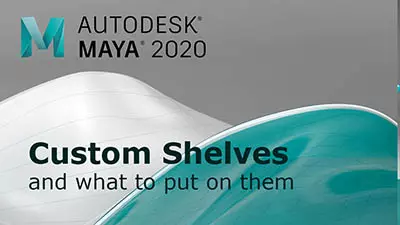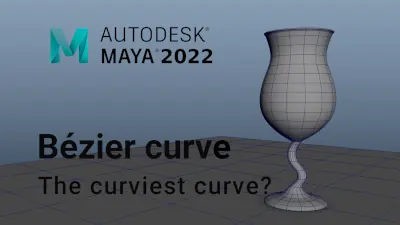Complex UV Layout in Maya
Over the last couple of years UV layout in Maya has changed for the better. In this course we're going to be taking a look at some of those changes as we UV map an entire character
#
1
15-04-2012
, 03:11 AM
Registered User
Join Date: Jun 2008
Join Date: Jun 2008
Location: Los Angeles, CA
Posts: 229
planning workflow for short film
What I don't know and can't seem to find is the best (word used loosely here, there are always many possible solutions to a problem) method for setting the camera(s?) and what-not. Since I don't know what ?s to ask I'll give examples.
In real life, if two characters are talking, you'd stage the scene multiple times, and depending on how you like to do it, shoot the whole scene from each angle or shoot segments from each angle. Both are of course legitimate methods. So in a simple scene, you might have a 2-shot angle and two close-up angles. If you only have one camera, you shoot the scene a minimum (assuming perfect performance) of 3 times.
In 3d animation, do you create 3 cameras, position them and animate them according to storyboards, and then render the whole scene out three times (or depending on hardware, scene complexity, and directoral style, render only portions), do you create a new scenefile for each shot, or something that I haven't mentioned? i.e. what are the more common workflows for getting footage to the editor?
Thanks!
--
Peter Srinivasan
Producer
#
2
15-04-2012
, 03:26 AM
EduSciVis-er
Join Date: Dec 2005
Join Date: Dec 2005
Location: Toronto
Posts: 3,374
#
3
15-04-2012
, 03:31 AM
Registered User
Join Date: Jun 2008
Join Date: Jun 2008
Location: Los Angeles, CA
Posts: 229
--
Peter Srinivasan
Producer
#
4
15-04-2012
, 04:06 AM
It's also very common to render "handles" to the animation. Usually about 10 frames at the beginning of the shot, and 10 at the end. This way, the editor has a bit more room to slide the shots around. However, the edit is usually pretty close to final, even before animation gets to it.
Imagination is more important than knowledge.
#
5
15-04-2012
, 04:18 AM
Registered User
Join Date: Jun 2008
Join Date: Jun 2008
Location: Los Angeles, CA
Posts: 229
--
Peter Srinivasan
Producer
#
6
15-04-2012
, 09:24 AM
That's correct. Referencing also imposes some rules on what you can, and can't do to referenced objects in the scene, such as change the UV coords; which is helpful as it keeps all assets the same across shots. If you need to make a shot-specific change, you can unreference the object, or create a new asset file with the changes in them.interesting. I'll have to do some research into referencing. I assume if I keyframe a referenced control and then change something in the asset file (as long as I don't delete the control or something drastic like that) the keys will stay the same in the scene file?
Note: I use the term asset here as a distinct object, not Maya's built in asset workflow.
Imagination is more important than knowledge.
#
7
15-04-2012
, 10:19 AM
Theres some good ways to do camera cuts, you can use multiple cameras, or you can key the camera to cut to save on cameras....I actually found a fairly useful 'tute' on youtube. The guys voice just grated but I got what he was doing and it kind of simplified the process. Nice to do some grass roots stuff for a change, well for me anyway.
Heres the link: Maya: Animating a camera - YouTube
If theres one good thing thats made my animation skills a little better in the last week, that would be turn off Auto Key every time you set a frame, the lead at work and the guy on this video says it too, it keeps everything in a nice order and the scene is cleaner and the animation is easier to handle. And dont forget your ease in and ease out, to keep things smooth when stopping the camera, select the curves and apply a flat tangent to them....
Edit: As Next Design says as well, use referencing, it can save heaps of time and keep the scenes to a minimum too -better for you in the long run. Maya's referencing has taken a critical beating over the years as ithas always been a bit clunky and non-responsive, but as of 2011 and 2012 its alot better by far, we used it on LockOut for everything and it was really stable, depsite fears of using it. Also its nice to note, that Maya 2012 has the replace object command in there now, something that Lightwave has had for years, you can replace objects in the scene at their local position either as pure GEO or an instance or either a reference object...and it actually works well too, so more for you to have a think about....hope that helps
cheers
Jay
#
8
15-04-2012
, 04:27 PM
Registered User
Join Date: Jun 2008
Join Date: Jun 2008
Location: Los Angeles, CA
Posts: 229

--
Peter Srinivasan
Producer
#
9
15-04-2012
, 04:34 PM
Subscriber
Join Date: Oct 2011
Join Date: Oct 2011
Posts: 139
Each scene has a set camera angle (same as in storyboard/leica) and you may only animate whatever is in the field guide. ..e.g. for a talking scene you can only animate the upper body of the character and don't have to worry about feet placement or anything like that, you can still cheat shifting weight and moving the body up and down etc.
I would always animate scenes relatively to the cameras instead of animating in the default view and then setting cameras around it, because you get a much better end result that way and you see in real time how it will look on screen.
#
10
15-04-2012
, 05:17 PM
I just spent 2 months working 15hour days to do a full cg 30sec commercial. there were 4-5 animators, 3 lighters, 4 compositors, 2 FX TDs and we have a large render farm.
i would say just do one camera per scene (baked and locked) and geo cache your anim. it'll make things much cleaner/lighter when rendering.
#
11
15-04-2012
, 05:20 PM
A friend of mine works freelance full time from home creating cg adverts and various intros for games etc, he manages fine, he works hard, but he does it an reaps the rewards too. Plenty of people do shorts, some good some not so....Ive seen plenty of good ones in my time.
Yep its all about cheating believe me, also comping doesnt matter, its how you choose to render it out. If you just had one camera for the whole scene, you render it per shot basis, so from 1 - 50 frames of the first shot, then 51 to 200 for your second shot, keep it all separate...easy
Horses for courses though
Jay
#
12
15-04-2012
, 05:26 PM
Registered User
Join Date: Jun 2008
Join Date: Jun 2008
Location: Los Angeles, CA
Posts: 229
 I'll probably start a wip once I have something to show. Thanks all!
I'll probably start a wip once I have something to show. Thanks all!
--
Peter Srinivasan
Producer
#
13
15-04-2012
, 05:31 PM
Registered User
Join Date: Jun 2008
Join Date: Jun 2008
Location: Los Angeles, CA
Posts: 229
I am confident about this one thing: I have to make this video, so I willam i missing something? There seem to be a lot of people lately who are very confident about doing their own full cg shorts. I going to have to be the pessimist here, but i don't see these succeeding any time soon.
I just spent 2 months working 15hour days to do a full cg 30sec commercial. there were 4-5 animators, 3 lighters, 4 compositors, 2 FX TDs and we have a large render farm.
 I know that there will be a myriad of problems that would've been avoided if I was in a larger production environment, just like the issues that cropped up (and even showed up) when I did APRIL FOOLS: SEGA Bass Fishing of the Dead - YouTube for April Fools, which took about a month to complete those few CG shots. But it is a great way to learn, as I don't have the creds to work IN a production pipeline. Next best thing is to screw yourself over by forcing an impossible project.
I know that there will be a myriad of problems that would've been avoided if I was in a larger production environment, just like the issues that cropped up (and even showed up) when I did APRIL FOOLS: SEGA Bass Fishing of the Dead - YouTube for April Fools, which took about a month to complete those few CG shots. But it is a great way to learn, as I don't have the creds to work IN a production pipeline. Next best thing is to screw yourself over by forcing an impossible project.Edit: That youtube embed ended up WAY bigger than I expected :< in fact, I didn't even want an embed. sorry
--
Peter Srinivasan
Producer
Posting Rules Forum Rules
Similar Threads
Changing the Film Gate
by salik89 in forum Programming replies 6 on 04-07-2016
Need help with an indie film project
by robertcouch in forum Maya Materials & Textures replies 0 on 17-02-2012
Open Source Film Production
by griffter in forum Maya Basics & Newbie Lounge replies 0 on 16-09-2005
Help Creating film on a film reel...
by SuperDave71 in forum Maya Basics & Newbie Lounge replies 1 on 24-02-2004
What makes Film.. Look like film?
by iron_tick in forum Maya Basics & Newbie Lounge replies 21 on 01-10-2003
Topics
Free Courses
Full Courses
VFX News
How computer animation was used 30 years ago to make a Roger Rabbit short
On 2022-07-18 14:30:13
Sneak peek at Houdini 19.5
On 2022-07-18 14:17:59
VFX Breakdown The Man Who Fell To Earth
On 2022-07-15 13:14:36
Resident Evil - Teaser Trailer
On 2022-05-13 13:52:25
New cloud modeling nodes for Bifrost
On 2022-05-02 20:24:13
MPC Showreel 2022
On 2022-04-13 16:02:13










